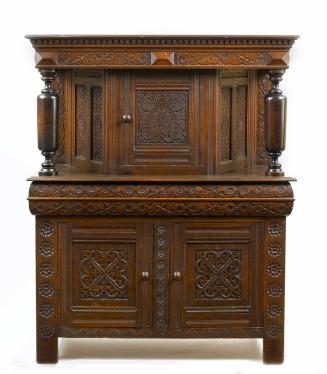Corner Cupboard
Original OwnerOriginally owned by
Reverend Eliphalet Williams
(American, 1727 - 1803)
Furniture MakerMade by
Unknown
Date1751-1906
MediumPine, brass and iron hardware
DimensionsPrimary Dimensions (approximate overall height x width x depth): 91 1/4 x 44 1/8 x 21 1/4in. (231.8 x 112.1 x 54cm)
ClassificationsFurniture
Credit LineGift of Mrs. Carl D. Jenson
Object number1966.40.1
DescriptionPine corner cupboard in the Chippendale, or rococo, style. The corner cupboard is a single unit, consisting of a deep, arched, recessed opening with a shell over two shelves, above a cabinet enclosed by two doors. The top has a band of narrow cornice molding over a horizontal rail. In the center, where the horizontal cornice molding touches the arch at the top of the shell, is a projecting, wooden, keystone. The keystone is flanked by a triangular recessed panel, and a vertical stile at the corner with an applied projecting panel. The recessed shell below the cornice moldings and arch consists of three petals in the center surrounded by fifteen recessed rays. The shell is flanked by a fluted pilaster, or flat column; the pilasters have a capitol at top that connects to the arch over the shell. Below the shell are two narrow shelves; each shelf conforms to the deep, curved shape of the cabinet, has a projecting, semi-circular area in the center, and a chamfered notch cut into the top surface to form a rest for plates. The cabinet doors below are plain, with a panel in the center that has chamfered edges. The top and side edges of the corner cupboard are framed by boards (a later addition) that project beyond the front of the corner cupboard and has a molded edge. The interior arrangement of the cupboard consists of one full-width shelf (now missing). Hardware includes a pair of iron butterfly hinges on the outer edge of each cupboard door. The right cupboard door has a small brass handle on the leftmost side.
Condition: The corner cupboard was removed from its original location and installed in a second home prior to acquisition by the museum. The top may have been cut down, resulting in the loss of some additional cornice molding. Additionally, canted elements may have been removed from each side of the corner cupboard. A frame has been screwed to the top and sides of the corner cupboard. Additional strips of wood have been added to the back of the corner cupboard, around the top front edge of the shell. The center vertical board below the shell has split. The corner cupboard has been refinished.
Design and Construction Details: The corner cupboard is formed with panel-and-frame construction. The shell is built up and carved out of 19 curved laminations, nailed together through the back. The back of the section below the shell is formed of eight curved vertical boards. These are secured at each side to the back of the pilasters with vertical glue blocks. The narrow shelves are held in place with nails through the curved back of the corner cupboard. The front edge of each shelf is molded with a quarter circle flanked by a fillet. The shelf above the cabinet is formed from a single board. The cupboard doors are formed of panel-and-frame construction and secured at each corner with wooden pins. The back and sides of the cupboard consist of a single panel inside a plain frame.
NotesHistorical Note: This corner cupboard was made for the home of Reverend Eliphalet Williams in East Hartford, between 1750 and 1751. The Williams house was demolished in 1906, but the corner cupboard was saved and installed in the donor's home at 212 Jordan Lane, Wethersfield, at a later date. In 1966, conservator Paul Koda removed the corner cupboard from Wethersfield and it was brought to the Connecticut Historical Society.Condition: The corner cupboard was removed from its original location and installed in a second home prior to acquisition by the museum. The top may have been cut down, resulting in the loss of some additional cornice molding. Additionally, canted elements may have been removed from each side of the corner cupboard. A frame has been screwed to the top and sides of the corner cupboard. Additional strips of wood have been added to the back of the corner cupboard, around the top front edge of the shell. The center vertical board below the shell has split. The corner cupboard has been refinished.
Design and Construction Details: The corner cupboard is formed with panel-and-frame construction. The shell is built up and carved out of 19 curved laminations, nailed together through the back. The back of the section below the shell is formed of eight curved vertical boards. These are secured at each side to the back of the pilasters with vertical glue blocks. The narrow shelves are held in place with nails through the curved back of the corner cupboard. The front edge of each shelf is molded with a quarter circle flanked by a fillet. The shelf above the cabinet is formed from a single board. The cupboard doors are formed of panel-and-frame construction and secured at each corner with wooden pins. The back and sides of the cupboard consist of a single panel inside a plain frame.
Object Note: This corner cupboard, also known as a buffet, was used for the storage and display of glass, ceramics and other small articles. This form was built as an integral part of the interior trim of the room, either in a corner or near a fireplace. Corner cupboards were often painted with bright and contrasting colors.
Original Use Note: The original owner of this corner cupboard, the Reverend Eliphalet Williams, was married to Sarah Williams. A copy of an inventory of the estate of Sarah Williams, taken 26 February 1800, lists the contents of the cupboard at the time of her death: 3 blue and white dishes, 12 blue and white plates, 6 blue and white teacups and saucers, 6 white plates, 3 white oval dishes, 12 white small plates, 1 white large pudding dish, 1 white quart mug, 1 white pint mug, 2 white bowls, 12 "smooth edg'd plates", 6 white butter plates, 3 Chocolate bowls, 6 "common" tea cups and saucers, 1 mustard, 2 "salts glass", 1 "green leaf plate", 3 tea pots, and 2 cruets. A copy of the inventory is in the file.
Status
Not on view













